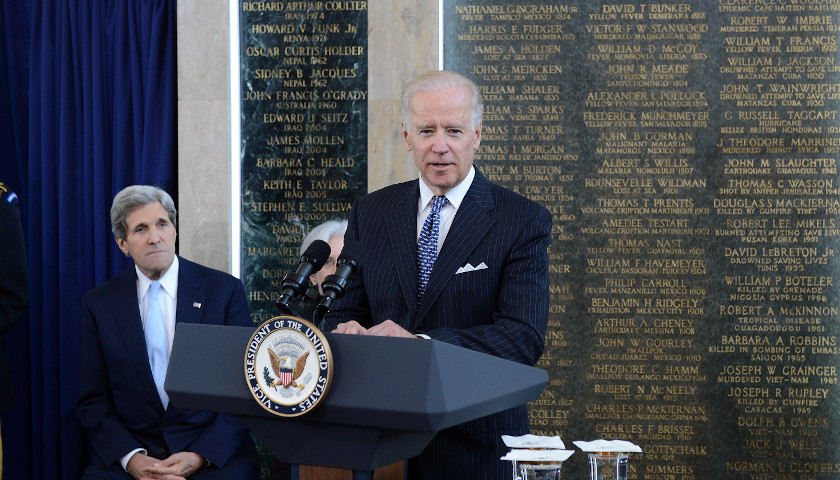by Jordan McGillis
Sleepy no more, President Joe Biden has taken to the Oval Office with gusto. On Wednesday, he resumed a climate policy blitz that has already included rejoining the Paris Agreement and deep-sixing the Keystone XL pipeline with an “Executive Order on Tackling the Climate Crisis at Home and Abroad.”
Among the banner proclamations from the Wednesday order are that Biden will pause the leasing of federal land to oil and gas companies, seal off 30 percent of federal land from development altogether, create a National Climate Task Force to wage “government-wide” battle on climate change, and require of the intelligence services a National Intelligence Estimate on the security impacts of climate change.
For a document spanning over 7,500 words, however, it is notably thin on concretes. Promises to “prioritize,” to “coordinate,” and so on abound, but only the federal land policies stand out as tangible.
To be clear, the effects of the de facto leasing ban will be very real to those in the line of the policy’s fire. Economic casualties will mount over time in the Western states, much larger portions of which are federal than in the East, South, or Midwest. New Mexico will be hardest hit, given that a third of its state revenue comes from oil and gas, much of it drilled on federal land.
Yet the immediate effects of this order are virtually nil. Leases for the coming years are in place — indeed records were set in the lead-up to the election last year — and production will continue. Even the order’s medium-range effect of knocking federal land production of oil and gas offline is limited in destructive capability. Federal land and water combine to produce only about 25 percent of U.S. oil and 15 percent of U.S. gas. That’s because most successful oil and gas parcels are not in federal areas. This order will eventually make us a bit more dependent on oil and gas imports, put upward pressure on prices, and cause a few hundred thousand jobs to evaporate. But it won’t get us off fossil fuels.
Harmful, this order is; revolutionary, it is not. Most of it, truth be told, is just more of the hot air we’ve come to expect from politicians and appointees on this issue. The steps the Biden administration have outlined do not match the severity of the situation that they allege. “The stakes on climate change just simply couldn’t be any higher than they are right now,” Climate Envoy John Kerry (whatever that title means) said in a Wednesday press briefing. “It is existential.”
If Kerry and Biden genuinely believe climate change will wipe out humanity, this order should make them red in the face. What does it amount to? Politicians will summit. Pledges will be made. Elbows will bump. But Biden’s plan to meet what he calls the urgent demands of the climate crisis is a farce.
He promises to “avoid setting the world on a dangerous, potentially catastrophic, climate trajectory,” ignoring the warnings of the vaunted Intergovernmental Panel on Climate Change (IPCC) that we’re on a trajectory right this very moment that will send us soaring past the Paris Agreement temperature threshold of 1.5 degrees Celsius above pre-industrial levels in a matter of decades. As has been the case every four years since we developed the ability to measure such things, global greenhouse gas concentrations will be higher when Biden’s term ends than when he entered office.
His “government-wide” approach to climate change will undoubtedly be grand in scope, and by throwing enough darts at the board he’s likely to score a hit now and then. But while the Biden approach presents a public posture of concern, it allows Americans to go on living in much the same way as we have for the last few generations. Biden is telling Americans what they want to hear: Those dirty oil workers in New Mexico are to blame, not you.
His order enables Americans to feel they’re on the right side of history even as they drive their SUVs from one climate-controlled, energy-sucking suburban building to the next. The administration lacks either a grasp of the facts or the courage to convey them: achieving Biden’s own promise of adhering to the Paris Agreement threshold by eliminating natural gas and coal from electricity generation in 15 years and being carbon neutral in 30 would require a discontinuation of the American way of life. It would require deep behavioral changes across our society. It wouldn’t be pretty.
One such approach would be to facilitate market-appropriate climate adaptation while clearing the regulatory path for high-value, low-emission electricity sources, namely nuclear. Yet among the 7,500 words of this executive order, the word “nuclear” — in what is perhaps the order’s greatest admission of fatuousness — appears not once. Another approach would be to tell the people of the United States that their lifestyle is incompatible with urgency of this crisis, that Biden intends to ratchet up energy prices to make them understand that, and that they need to become more comfortable living with less. I know which of these two approaches I’d pick, but either would be more honest than the smoke-and-mirrors on display Wednesday. One week in the White House and Joe Biden has already proven his approach to climate deeply unserious.
– – –
Jordan McGillis is a policy analyst at the Institute for Energy Research, a public policy think tank that examines the functions, operations, and government regulation of global energy markets. He resides in San Francisco.




